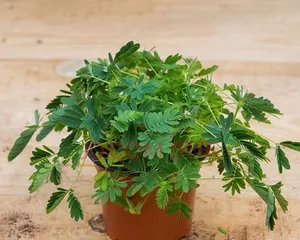Mimosa is a very special plant that can produce beautiful flowers in spring, summer, autumn, and winter. However, for different seasons, we need to master different watering methods to help the mimosa grow strong and healthy. Next, I will introduce in detail the watering techniques for mimosa in spring, summer, autumn, and winter.

1. Watering Frequency for Mimosa in Summer
In summer, mimosa should be watered once a day. Because the weather is hot and windy in summer, the soil of mimosa is easy to dry out and needs frequent watering.
2. Watering Frequency for Mimosa in Winter
In winter, the growth rate of mimosa is slower, so the watering frequency can be reduced to once a week. However, it should be noted that the air is dry in winter, and the pot soil needs to be kept moist.

3. Watering Tips for Mimosa in Spring
In spring, mimosa needs to be watered thoroughly, but avoid overwatering to affect the health of its roots. If the pot soil is not moist enough, you can increase the number of waterings in the morning or evening.
4. Watering Tips for Mimosa in Autumn
In autumn, the growth rate of mimosa is faster, so the number of waterings needs to be increased. However, it should be noted that the air humidity is higher in autumn, and excessive watering should be avoided to prevent root rot.
5. Pay Attention to Mimosa's Love for Sunlight
Mimosa loves sunlight, but it cannot be exposed to scorching sun. In summer and autumn, it is best to place the mimosa in a semi-shaded area to avoid direct sunlight.

6. Be Good at Observing the Growth of Mimosa
The growth rate and watering frequency of mimosa need to be adjusted according to the actual situation. If the color of the mimosa's flowers and leaves fades, it means it is short of water and needs to be replenished in time.
7. Adjust the Amount of Water
The amount of water should vary by season. In summer and autumn, it needs to be watered thoroughly, while in winter, the amount of water should be reduced to avoid the roots becoming waterlogged.
8. Avoid Overwatering
Overwatering can lead to root rot and pests and diseases in mimosa. Pay attention to the amount and frequency of watering.
9. Be Good at Using Terracotta Pots
Terracotta pots can promote the evaporation of water from mimosa, avoiding excessive water. At the same time, terracotta pots also help regulate the root respiration of mimosa.
10. Do Not Water Directly on the Flowers and Leaves
The flowers and leaves of mimosa are relatively sensitive and can easily deform when they come into contact with water. When watering, it is best to drip the water onto the soil.
11. Fertilize Reasonably
Reasonable fertilization can improve the pest and disease resistance of mimosa and promote growth. However, it should be noted not to over-fertilize to avoid harming the mimosa.
12. Clean Up Fallen Leaves in Time
Fallen leaves can have a negative impact on the growth of mimosa and can easily lead to pests and diseases. When fallen leaves are found, they should be cleaned up in time.
13. Increase Air Humidity in Winter
The air is dry in winter, which can easily affect the growth of mimosa. You can help the mimosa get through the winter smoothly by increasing the air humidity.
14. Control Indoor Temperature Reasonably
The indoor temperature should not be too high or too low and should be kept within a suitable range. Too high a temperature will cause the leaves of mimosa to turn yellow, while too low a temperature can easily cause the mimosa to wither.
15.
Mimosa is a relatively easy-to-care-for plant. As long as you master the watering techniques and other care methods for spring, summer, autumn, and winter, you can help the mimosa grow healthy and strong. I hope this article is helpful to everyone's care work.